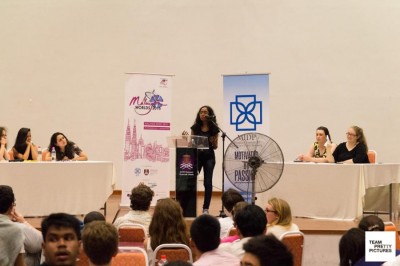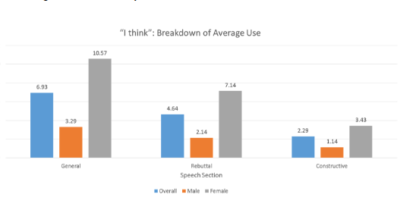When Women Speak, we, er, Think? A Conversation with Miriam Kohn on Gendered Communication in British Parliamentary Debate
The use of language in university debating hasn’t been studied a lot so far. Miriam Kohn from the University of Rochester did some research – in this interview, she tells us about her results and thoughts on the use of “hedging”. Edited for length & clarity with entire thesis and speech transcriptions available here.
Disclosure: The interviewer is an assistant coach for the University of Rochester Debate Union, which Miriam competes on behalf of.
Achte Minute: Hi, so, to start off, could you tell me a bit about yourself?

Miriam Kohn defends her senior honors thesis “That’s Debatable: Gender Presentation and Hedging” at the University of Rochester Linguistics Department – © Graeme McGuire
Miriam Kohn: I’m a senior at the University of Rochester completing a major in linguistics. I’m president of the debate team and have held leadership positions since freshman year. I am heavily involved in research, in both domestic violence and linguistics, and I also work as a speaking fellow. When I’m not doing stuff for class, work, or research, I spend most of my time doing things related to food, word games, or the outdoors. Next year I will be going to Laos with a Fulbright to teach English and coach community debate. I guess it’s fair to say I am heavily involved in a lot of things.
AM: That sounds like an understatement! So I know you have been researching gendered communication in competitive British Parliamentary debate. Could you tell us a bit about that research?
MK: I’m doing an undergraduate honors thesis on gender presentation and hedging. There is some research in the Monash Debate Review based on the gap in competitive debate success by gender (Paul Pierson in 2013, Claudia Hyde in 2015). However, I wanted to ask why this gap happens. I pulled out-rounds from a variety of major tournaments, controlling for skill level and regional bias. While gender identity information was not available self identified, I selected 25 speakers with male presentation and 25 with female presentation from out-rounds at a variety of tournaments including the Yale Intervarsity, Worlds Universities Debating Championships (WUDC), Austral Women’s, and even, I think, the Trinity Intervarsity.
I analyzed them for differences in speech patterns, specifically, what is known as hedging. People quibble on the exact definition of hedging but it is in general anything said that is reducing commitment to a statement (for example, the difference between saying “X is probably true” and “X is true”). I focused on the differing use of “I think”/”we think” by gender presentation: When, how often, and how much sequentially that hedging was used. I found a statistical significance in the use of hedging between male and female gender presentation. In absolute numbers, females used more hedges. The average use per speaker was higher, with a greater number of sequential uses of “we think.” If you break it down by constructive and rebuttal, females use significantly more “I think” and “we think” in rebuttal, and males use mainly “we think” in constructive.
AM: Could you speak a little about other research into gendered differences in competitive speaking and gendered language?
MK: There is abysmally little research into gender and hedging, which is a lot of the reason why I decided to research this. What we do have falls into broadly two camps:
The first is based on court transcripts. O’Barr and Atkins 1980, in particular, studies supposed differences in speaking and suggests that they are generally related to differences in social positions rather than gender. For example, a blue collar male witness will generally hedge more than a white collar women witness with a PHD. There have been many spinoffs of such work. The problem being, of course, that court transcripts are not only extremely niche, they are also prepared in advance and not good examples of natural speech.
The next is speculative gender studies lens of speech (Robin Lakoff is a good example of this): however, introspection is the source of insights rather than a data source. While it may be true that women use more specific color words, it is unclear that women would hedge more because you say it is so.
While hedging work is good it has been independent of gender, and I have not seen anything else on hedging in debate, most specific research on debate has been from the policy debate format and theoretical (for example, frameworks of analysis used within debate speeches) or based on the debate community rather than speeches (for example, Pamela Steppe looked at gender competitive disparities in policy debate, sexual harassment, and disparities between male and female program directors) but that does not look at the speeches themselves.
Because this field has not been well researched I wanted to publish my transcripts and make them available, thinking that if people did not have to transcribe speech they would be more likely to think and expand on this work.
AM: So what generally is the way hedging is perceived?
MK: One of the ways to interpret findings is the use through hedging as to open new space. While hedging gets a bad rap, everyone hedges all the time: If you never hedge, you come across as a conceited airhead, and you look stupid when you’re wrong. Hedging is a way to show politeness and deference and obey the world of linguistic Gricean maxims, that one should to the best of their ability tell people the truth. When the truth is unknown people should communicate what they are uncertain about: as a mark of power, to insulate themselves from criticism. To hedge is generally not bad. Undeniably, it serves an important and deliberative role in speech and gets a bad rap in pop media such as blog articles published in Slate, the New York Times, and more. For example, Slate has a blog called Lexicon Valley that talks about issues of language and womens’ issues, including hedging.
While everyone hedges whether male, female, or nonbinary, the difference is when and how much. The idea that hedging can make an argument stronger is logical: There is generally a high cost to be disproven and I would like to see more research on what results are found when one is unproven: for example, if there is a high cost to a judge thinking you are trying to pull the wool over their eyes and are then less likely to vote for you, hedging strengthens your argument and renders you less falsifiable.
AM: How does the competitive debate community generally regard hedging?
MK: So I will speak mainly for the American British Parliamentary (BP) debate community, where hedging is officially discouraged as filler or inefficiency. However, people still use hedges even though coaches train them out so clearly hedging receives some regard even if we are not conscious of it.
AM: How does competitive debate translate to the rest of society, especially given the amount of debate that is pre-scripted? Do you think that normal speaking patterns inform debate speeches or that speaking within a debate speech is representative of normal speech patterns?
MK: I used BP debate because other kinds of debate have parts of speeches pre-scripted if not the entire speeches. BP debate is a natural sub-sect of society (college age students speaking persuasively and between the ages of 15 to 25). There are always slight differences from situation to situation: BP is as specific a context as any other context that may be called “natural speech.” Without access to non-generalizable data, my research could be generalized as a trend even if not representative as proportions or as exact numbers. My research was also significant because the speeches used were not just from members of the community but those who are recorded speaking and generally seen as “good”: You don’t clear to Yale IV semifinals or to WUDC quarterfinals unless you are doing very well.
AM: Do you think it is possible that competitive speakers expressing as female are rewarded for and end up using these types of hedges more than male performing speakers?

Women’s Night in Malaysia with a debate on the motion “This House regrets the role of alcohol in social life.” – © 2014 Matthias Carcasona
MK: While I can’t speak to whether this is accurate with the data I have, it is certainly possible and I would love an analysis of listener reactions. It might be difficult to get a panel of BP judges but even the average person would be useful. A prevalent opinion is that those who are female presenting trigger bias and run the risk of being seen as more aggressive (if they talk too quickly, wave Points of Information down, use other linguistic phenomena): It is no surprise to find out that this evidence may back up the idea that female debaters do not want be seen as too aggressive. Imagine you are a female speaker: A judge’s dislike of your manner of speaking works against you because it changes how the judge starts off in perceiving your manner of speech and thus persuasiveness of arguments (this could especially impact speaker points, also). Like I said I have no specific evidence but it would not surprise me.
AM: You mentioned that this research was inspired by your observation on the significant gaps in research conducted on gendered speech & research conducted on speaking patterns in debate. To what extent was your research also informed by your experiences within the debate community or observations in a debate round?
MK: This was not inspired by experiences of sexism: I only once have felt like remarks received while debating were remarks specifically directed at my gender: Rather, I was inspired by watching the debate community create policies for increasing retention of and promotion of females in debate, leading up to the discourse around the affirmative action policy passed by the WUDC council this year, including months of discussing how to reward/recruit women and help them be successful as judges. In my personal experience as being a woman, this is an important discussion within the debate community inasmuch as we value diversity of perspective in a number of ways and this ought certainly be true of gender as well.
AM: What kinds of policies (both official and unofficial such as norms coaches, judges, and tournaments could adopt) do you think the debate community should consider in responding to the results you’ve found?
MK: Well, the first and most obvious is that norms be more documented: We can’t discuss what we can’t pin down in a meaningful way. If there are large differences in speech by gender and if there are certain norms discouraging those speech utterances, at a certain point we do need a community discussion about how much to value some speech types, if we ought change how we evaluate them, and if we can or should tell female and nonbinary to think and speak a certain way.
What is more interesting is what it discounts: A lot of discussion within the debate community reflects a belief that non-male chairs could solve some of the problems of the sex gap. However, the kinds of judges promoted to chair are successful inasmuch as they have accepted community norms. If there are gendered differences in speech patterns it is unclear why female debaters have a better chance of being rewarded under a female chair than under a male chair.
I also think it creates an interesting question about how we do coaching selection: What does it mean for debaters to be coached by a male, female, or nonbinary coach that has inculcated these norms: I think discourse could be called for on those grounds. Lastly, these numbers call into question the use of speaker points, especially as a mechanism for breaks. They don’t point to a specific alternative being preferable. They do, however, suggest that rewarding different speech patterns through speaker points could be a direct link to a gendered gap in competitive success.
AM: You mention that female or nonbinary chairs are likely to have bought into community norms on hedging in evaluating speakers. However, do you think that gendered speech patterns of debaters are likely to be enacted by such chairs in using hedging or unassertive language?
MK: There are speech patterns unique to cultural authority in any context but in a debate context I am not sure what type of speech patterns that would be and this is speculation based on my personal experience as a debater or judge: There is always a tug of war for a chair, on the one hand to not seem too mean or aggressive, and on the other hand to not seem uncertain of the call. The interesting question is that as much as it is good to promote non-male chairs in and of itself and to reward diversity of perspectives in judging, they are still subject to the same pressures and circumstances: this can’t be the silver bullet for issues of equity in competition.

Miriam found a striking difference in the use of “I think” by gender (c) Miriam Kohn
AM: Continuing with this hypothetical in which chairs mimic gendered speech patterns observed among competitive debaters (especially likely given these are usually the same people), do you see more hedging by chairs as likely to impact their success as judges (which is generally determined by feedback and perceived credibility)?
MK: I think that this hedging can be incredibly positive when used within the discussion, as a way to build common ground, thus producing a more positive reaction from debaters and judges. Hedging could also make a judge seem kind or polite. However, the perception of hedging could be differently perceived based on how well the speaker is known- hedging with a dear friend is seen differently than with someone you just met that round.
To move to another hypothetical, most people fairly generalize that it is likely there are differences by gender identity just as there are differences by gender identity and presentation in speakers and the world at large. Honestly, we don’t know. While it is an interesting question and study to do I can’t comment on it based on what I have researched.
It is revealing that hedging comes out in rebuttal when speakers are generally less prepared. Falling back on “we think,” which female identified speakers are prone to do, is distinct from falling back on other varieties of hedging in that the speaker is appealing to partnership authority. So one question that this produces is why it is more acceptable to fall back on hedging than it is to plant hedging within your speech.
It is interesting to compare hedging in rebuttal relative to other markers of engagement in rebuttal because elements that occur on the periphery of a statement or elements that invoke responses such as turn-taking aren’t all hedges and I would be very interested to see how those play out in the rebuttal section.
AM: Could you give me an example?
MK: So a lot of it is not verbal if you will: Paucity of phrase, how you say it with stress and verbal tonation (moving pitch up/down). All of these things require very high quality audio files to research. The ones I had access to were good enough to transcribe but not good enough to do this kind of analysis on. Another example of a peripheral element is emphatic: “That is true” as opposed to “yes, that is true” (mark the response, peripheral, but not hedging to mark uncertainty or lack of speaker commitment to the utterance).
AM: And finally, would you say “I/we think” is a step away from persuasion or makes statements more persuasive? Why do speakers use it?
MK: There is the concept of a private information domain within linguistics: An area of information only the speaker would have access to (for example, if I say “I think this book is great” and you say “no you don’t,” you sound foolish; “I think” or “we think” sets the utterance within the private information domain of the speaker so it is not falsifiable). There are a number of possible explanations for these things to crop up within rebuttal:
First, to make the speaker more persuasive through building common ground. Second, to make the information less falsifiable because it is within the speaker’s private domain. Third, because it is a less confrontational form of delivery. Fourth, to build credibility through partnership authority. These reasons are not mutually exclusive but rather likely work in tandem with one another.
AM: Thank you very much!
Miriam Kohn, University of Rochester ‘17, is recipient of the 2017 Fannie Bigelow Award and the 2016 Alysia Cockrell Woman of the Year Award. Miriam is a reigning Pan-American Champion, US Universities & North-American Universities Quarterfinalist, and Eastern Championships & America’s Cup Semifinalist, among her many other (30, to be precise) debate accomplishments. Miriam hopes that open access for research purposes to her transcripts of 50 speeches will prompt more research into debate & speaking.
Mittwochs-Feature: Every Wednesday at 10.00 a.m. the Mittwochs-Feature features an idea, interview or book regarding debate – usually in German, sometimes in English, sometimes both. If you would like to start a debate please mail us your idea to team@ achteminute.de .






